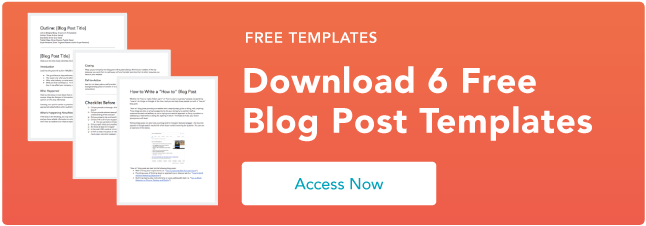Our 2023 Marketing Trends Report shows that 29% of marketers use a website or blog to attract and convert leads.

The enduring importance placed on blogging isn't shocking. Blogs are integral to most digital marketing plans because they can:
- Boost SEO
- Improve overall site traffic and a brand's online presence
- Help prospects learn more about your industry, brand, product, or service
However, starting and running an effective, traffic-generating blog requires much time and energy. Plus, if you're a marketing manager on a tight budget, you may wonder, "Will blog posts actually lead to purchases?"
To answer the question, here's some research we conducted to help you determine if a company blog suits your marketing strategy.
Download Now: How to Start a Successful Blog [Free Guide]
Important Blog Statistics Marketers Should Know
Do Blog Posts Lead to Purchases?
How to Lead Readers to Purchases
Creating Your Blog Nurturing Process
Important Blog Statistics Marketers Should Know
As previously mentioned, blogs remain essential to many marketing strategies, and there are statistics that show why. Here are some blog statistics we gathered from our Marketing Trends Report:
- One in three marketers are leveraging their blog or website as well as SEO to land on SERPs
- Blogs, social media shopping tools, and influencer marketing are all tied for the highest ROI of any marketing channel

- 33% of marketers are leveraging blog posts in their marketing strategy.
- Blog posts, interviews, images, and podcasts will see high first-time use among marketers in 2023.
Do Blog Posts Lead to Purchases?
The growth of other content strategies, like video marketing, might make you think consumers will only buy products after seeing them on other platforms.
However, when we surveyed 300 consumers via Lucid and asked, "Have you ever purchased something from a company after reading a blog post?" a whopping 56% said, "Yes."

Furthermore, according to our trends report, blog posts are among the media formats with the highest ROI, along with videos, images, and podcasts.
Why Blogs Lead to Purchases
If your company has a blog that discusses your industry or how your offerings can help with the average reader's everyday pain points, your audiences can discover and gain trust in your brand's expertise. That trust and credibility could ultimately lead to purchases.
Why? Suppose a prospect trusts the advice or information given in your blog posts. In that case, they might trust that your offerings are better quality than your competitor's because your brand knows the industry, what customers want, and the pain points your product or service solves.
Even if you prefer video, social media, or visual marketing strategies, it's important to remember that blogs can help you sell products in ways other content types can't.
Videos and images, for example, might only give prospects a glimpse of how a product or service works. However, blog posts can offer extensive information that would otherwise be cut from videos and images to avoid overwhelming viewers on social media.
Blog posts can also increase your search ranking and allow more opportunities to link directly to a landing or purchasing page. Consumers can find your content via search, then read your post, and easily click to a product purchasing page after your content persuades them to buy a product.
Additionally, because most blog sites allow you to embed videos, podcasts, and imagery, your company blog can also be a great place to promote your other marketing assets while still informing prospects about your brand.
How to Lead Blog Readers to Purchases
In the following year, consider a content marketing mix that includes blogging. How do you persuade shoppers with your blog posts? Here are a few quick tips.
Strategically place product page links and CTAs.
Mentioning your brand, product, or service where it feels natural in your blog posts is an excellent way to generate leads and purchases.
However, you can also use hyperlinks to link to product pages or CTA buttons that draw slightly more attention to a product or offer without directing reader attention far away from the blog post.
At HubSpot, we usually place at least three CTAs related to a blog topic in each post:
- A text-based CTA in the introduction
- A larger banner image at the bottom
- A slide-in CTA that shows up to the side of your text as you're scrolling through the middle of the post.
This allows three mentions of a product or offering without interrupting the reader's experience.
The image below is an example of our CTAs.
 From top to bottom: A text-based CTA, a slide-in CTA, and a bottom CTA. (Image source)
From top to bottom: A text-based CTA, a slide-in CTA, and a bottom CTA. (Image source)
Offer a free resource:
You probably noticed the above CTA examples included links to free resources. Though it may sound counterproductive, free resources can help your blog lead consumers to make purchases. Here's how:
If your brand sells a subscription, service, or product that's pricier or needs your company's leadership approval, blog readers might need more than a few blog posts to trust your brand and invest in your product. In that case, you should focus on lead nurturing rather than sending blog readers directly to a purchasing page.
HubSpot and many other blogs have grown their contact and qualified lead lists simply by creating a free downloadable resource, such as an ebook, template, or research report, and offering it through CTAs at the end of blog posts.
Below is an example of a recent free research report resource we offered at the end of one of our Sales Blog posts:

To access free — but gated — offers, readers must give basic information about themselves and their company. From there, they receive an automated email or instant download of the resource while also becoming a contact — or lead — and enter our lead-qualification process to see if they could be an excellent prospect to reach out to.
The HubSpot Blog's free resource strategy results in thousands of qualified leads per year that could convert into HubSpot customers. You can learn more about how to implement it on your blog here.
Remember, quality beats over-promotion.
In another recent Lucid survey, one-third of our general consumer respondents most commonly read blog posts to "learn something new." Meanwhile, roughly 20% read blog posts for the sake of entertainment.
It's important to remember readers will likely find your blog because they're looking for information related to an industry they work in. They may also want to learn something related to their hobbies or need solutions for a pain point in their daily or professional lives.
Odds are, they're not looking solely for promotional content. If a reader visits your blog site and finds nothing but blog posts filled with product shots and cheesy advertorial language, they'll likely lose interest in your content and may not develop the sense of trust needed to make a purchase.
It's wise to place a few un-intrusive CTAs in your blog posts and to mention your product or service when it feels relevant. Ensure that your content primarily offers valuable guidance, advice, and information to help your reader fulfill their needs.
For example, in this post about AI social media tools, we give valuable information about implementing AI-based technology in a social media process while listing HubSpot as one of the tools readers can use.
While we still mention our offerings, the post aims to show readers how multiple AI tools can streamline a marketing process.
Creating Your Blog Nurturing Process
Every brand has a target audience with different interests and content needs. While one blog strategy, such as free resources, will work well to generate qualified leads for a B2B company, other tactics, like simply linking to a product in blog posts, might be more lucrative for consumer-facing brands.
As you focus more on turning your blog traffic into revenue, keep these questions in mind:
- What information is valuable to my audience?
- Does my product require lead nurturing, such as gated offers?
- Will the tactic I'm using seem over-promotional or disengaging to my audience?
Want to learn more about how the HubSpot blog generates leads? Check out this post from one of our content acquisition managers. Or, take down these tips on how to make money blogging.
Before you check out those pieces, download the free resource below.









![The Resources You Need to Get Started With Business Blogging [In Under 100 Words]](http://cdn2.hubspot.net/hub/53/file-251321191-jpg/Blog-Related_Images/get-started-blogging.jpg)
